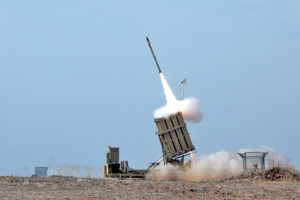Israel’s Success Must Not Obscure Increase in Hamas Capabilities

Israel Defense Forces and Nehemiya Gershuni-Aylho נחמיה גרשוני-איילהו (see also https://he.wikipedia.org/wiki/%D7%A7%D7%95%D7%91%D7%A5:Flickr-IDF-IronDome-in-action001.jpg ), CC BY-SA 3.0, via Wikimedia Commons
One of the most indelible images from this spring’s Gaza conflict is the Israeli night sky streaked with rockets and Iron Dome interceptors rising to meet them. However, as the authors found on a detailed fact-finding trip to Israel this summer, the remarkable success of Israel’s air defenses must not obscure real advances in Hamas’ military capabilities or their implications for U.S. operations.
A new report from the Jewish Institute for National Security of America (JINSA) shows how Hamas and the Israel Defense Forces (IDF) used the seven-year relative lull preceding this May’s fighting to absorb lessons and adapt their forces after the demanding 50-day conflict in 2014. Parallel to Israel’s interwar improvements, including its innovative uses of artificial intelligence and counter-tunnel technology, Hamas’ development of new weapons and tactics flew largely under the radar before debuting this spring.
At first glance, this year’s conflict was more of the same, as Hamas and other armed groups in Gaza launched rocket barrages indiscriminately at Israel. But May 2021 saw a much higher tempo than ever before, with almost 4,500 munitions fired at Israel in just 11 days – roughly the same amount as in the entire 2014 conflict. With Iranian encouragement, Hamas’ fire plan also became more sophisticated. It ditched previous efforts to overwhelm Iron Dome’s command and control with small salvos fired simultaneously toward multiple fronts in Israel, favoring much larger volleys to overpower a single battery.
And while Hamas possessed as many rockets as 2014, these boasted larger payloads and longer ranges – up to 70-100 miles, covering Tel Aviv and northern Israel. This is all the more impressive given Hamas’ growing ability and necessity to manufacture weapons indigenously once Egypt sealed off smuggling routes after the previous conflict.
Concerted research and development by Hamas’ military engineers were evident in other areas as well. For security reasons, the IDF strained to explain its rationale, but its airstrike on Gaza City’s AP and Al Jazeera tower targeted new electronic warfare capabilities Hamas was developing to degrade the effectiveness of the Iron Dome. The conflict also saw the first use of suicide drones by Hamas. It sent low-flying, maneuverable unmanned aerial vehicles against an offshore natural gas platform and other targets. Hamas also attempted to launch an explosive underwater drone for the first time.
Hamas was busy underground during the interwar period, too. It excavated an elaborate, 200-mile network of tunnels to command and move combat forces, launch rockets and hide weapons. This subterranean infrastructure was meant to shield military assets from Israeli airstrikes, as well as surprise and attack any IDF ground incursion into Gaza.
Despite these changes, one thing remained the same from prior conflicts. Hamas intentionally violated the law of armed conflict (LOAC) by indiscriminately attacking Israeli civilians with rockets. It deliberately used Gazan civilians to shield its military assets to spread the false narrative that any ensuing civilian casualties were evidence of Israeli war crimes.
The IDF quickly and successfully countered these new military capabilities, though as in 2014, it struggled against Hamas’ more rudimentary antitank missiles and mortars.
More importantly, Israel lost strategically in the court of international opinion, despite complying with the same laws of war that Hamas deliberately exploited.
This conflict is a harbinger of growing threats to the United States, Israel and other law-abiding militaries from “hybrid” adversaries that fight unconventionally with advanced weaponry – from the Islamic State in Raqqa and Mosul to Russian “little green men” in Crimea and Donbas. The fighting in Gaza also points to how U.S. forces may need to operate in even more complex urban terrain against more capable adversaries that, like Hamas, seek victory not on the battlefield but by delegitimizing lawful operations.
American forces must prepare to fight, win and maintain their commitment to LOAC in this challenging and evolving environment. Learning from and training with partner forces like Israel that are experienced in such operations could prove beneficial. Drawing from the IDF’s shortcomings, planning, professional military education, and strategic communications also must adapt to the alarming scale and speed at which disinformation now travels worldwide.
The Pentagon is already pursuing innovations similar to Israel’s use of artificial intelligence to operate quickly and precisely in such complex environments. Israel’s military successes in May 2021 underscore the need for difficult and potentially disruptive reorganizations that can fully utilize these cutting-edge technologies against enemies far more capable than Hamas.
Finally, Hamas’ new capabilities reveal the need for concerted U.S.-Israel cooperation on research and development – as well as joint tactics, techniques, and procedures – to effectively and sustainably defeat threats posed by technologies that are proliferating into the hands of unconventional adversaries.
What happens in Israel tends not to stay there. The United States has been warned and must heed that warning.
Lt Gen (Richard Natonski (U.S. Marine Corps, Ret.), former Commander of U.S. Marine Corps Forces Command, and Lt Gen Thomas Trask (U.S. Air Force, Ret.), former Vice Commander of U.S. Special Operations Command, are members of the Gaza Assessment Task Force at JINSA, where Jonathan Ruhe is Director of Foreign Policy.
Originally published in RealClearDefense.